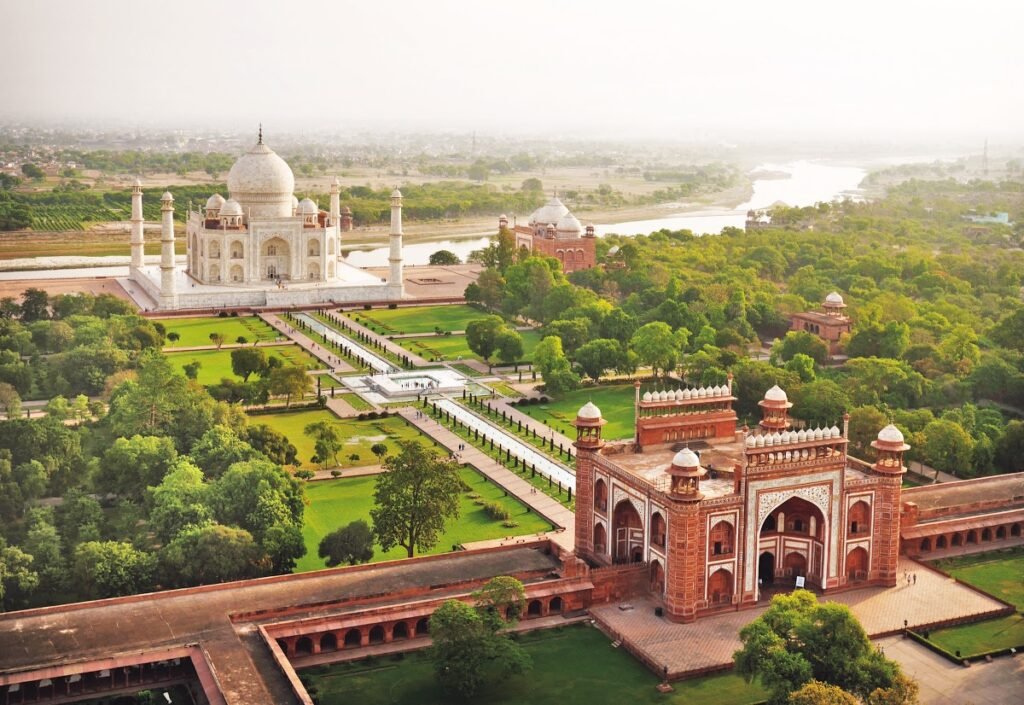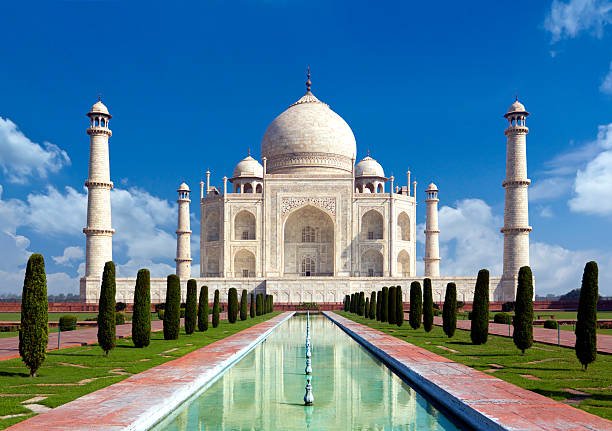History and Legend of the Taj Mahal
The story of the Taj Mahal started back in the 17th century when there was a Mughal emperor named Shah Jahan who loved his wife Mumtaz Mahal. She had died during the birth of their child; therefore, he wanted to create something fantastic mausoleum in her memory. Commissioning for the same was given by Shah Jahan in the year 1632 and ended in 1653, Thousands of highly skilled artisans and craftsmen from every part of the vast Mughal Empire took part; the monument epitomised extreme love and sorrow felt by Shah Jahan for Mumtaz Mahal.
Architectural Wonder of Taj Mahal
The Taj Mahal represents a hugely attractive architectural style that was formed essentially by integrating the influences of Persian, Islamic, and Indian. The great white marble dome featured the most “onion dome”-flanked by four smaller domes. Symmetry in the major structure rests on a raised platform, altogether symmetric with a sum total of four minarets at each corner. All this symmetry coupled with the reflectivity of marble used creates a dazzling effect especially at sunup and sundown.
Materials Used in Construction
Save for the rare and semi-expensive stones like jade, crystal, turquoise, and lapis lazuli, variegated amounts of white marble that were used in constructing the Taj Mahal were quarried from Makrana, in Rajasthan. The skilled craftsmen then went ahead to employ the pietra dura or the inlay technique whereby the colored stones were cut and fitted into the marble to form an intricate flowery pattern as well as geometrical designs.

Symbolism in Architecture
Much more than a monument to love, deep symbolism espouses the whole edifice. The large dome represents the heavens while the minarets are believed to symbolize the gesture of hands standing in a prayerful pose somewhat away from the main structure. White marble depicts purity while the usage of floral motifs depicts the theme of paradise described in holy Islamic texts .
The Gardens of the Taj Mahal
The gardens of the Taj Mahal form part of the original structure. Outdoor symposium gardens symmetrically disposed along the perpendicular and cardinal axes, divided into four quarters by broad raised pathways, with a long rectangular pool in the center flanked by rows of fountains creating a mirror effect of the mausoleum. This was a feature common in the Mughal gardens since it symbolizes the Ch Minh or a paradise garden and conformed to the belief of life after death.
Main Mausoleum and Its Features
The Taj Mahal itself is the Central Mausoleum of Mughal architecture: in the middle, one large bulbous dome and at the corners-four small domes with an elevated platform. Inside, the main chamber is beautifully decorated with inlaid and exquisitely carved cenotaphs of Mumtaz Mahal and Shah Jahan. Their actual graves are much lower in a crypt because their tombs are forbidden by Islamic tradition.
Minarets Use and purpose The four minarets besides being decorative served another very practical purpose for the Taj Mahal as well, their structural engineering: So, the minarets are constructed pretty at a distance away from the main structure, a little slanted outside so that, in case of an earthquake they fall away from the mausoleum rather than on to it, In fact, it was a brilliant idea. This is a test of the fact that its builders had possessed an intelligent fusion of engineering expertise together with the aesthetic appeal of the Taj Mahal.
Calligraphy and Inlay Work

Some of the jolting features of the Taj Mahal are the wide uses of calligraphy and inlay work. In this respect, the walls of the Taj Mahal have verses from the Holy Quran inscribed in beautiful Thuluth script on them-the works of the famous calligrapher Abd ul-Haq-carved out in black marble, nice contrasting whites to the white marble of the building, and hence adding religiously to the spiritual aura of the mausoleum.
However, this remains a legend as the “Black Taj Mahal,” for no historical evidence comes out for the same. Other legends say that the artisans associated with the Taj Mahal had their hands chopped up, so that it would never be employed to build any structure that would be more beautiful. This again could be a myth.
Conservation Efforts and Challenges
Its preservation has been one of the biggest challenges since time immemorial. The industrial and vehicular pollution had given yellow discoloration to the white marble. This prompted various conservation efforts in the recent times. The Indian government and various international organizations have been trying hard to clean up and restore the monument to its previous glory but the battle with pollution and environmental degradation continues .
Tourism within the Taj Mahal
It is among the most visited Earth places listed with UNESCO’s World Heritage. Millions of visitors from different parts of the world come to see it each year. To save this monument from such a huge flow of tourists, the Indian government has adopted different measures. For instance, the limitation of the number of visitors per day, or prohibition of vehicles in its surroundings.
The Taj Mahal and Popular Culture
Indeed, the Taj Mahal perennially inspired popular culture-from songs to films to art; the beauty of the Taj came to symbolize love and beauty. This iconic status turned the monument into a signifier for India itself on postcards and traveling brochures, even currency notes.
Controversies and Debates
Notwithstanding its appeal on all levels, a number of controversies and debates also surround the Taj Mahal. In fact, some historians and few political leaders never allowed the monument to shed its controversial mantle and go all the way to even question about its origin, claiming it was originally a Hindu temple. However, all those claims bear very little in terms of credible evidence. Again, how best to preserve and restore the Taj Mahal-balancing the needs for preservation against the demands for tourism-is a matter of continuing debate.
Conclusion
The Taj Mahal is infinitely more than just a building; it is even more than anything as prosaic as a work of architecture. It is, on the contrary, a symphony of art and architecture combined with emotions. Minute information tells of deep symbolism amongst others. This timeless beauty speaks volumes and captures the heart of all those that come into its presence. The Taj Mahal was symbolic of a reminder of undying love; it told of the power of human emotion, further mentioning an endless legacy of the Mughal Empire.




